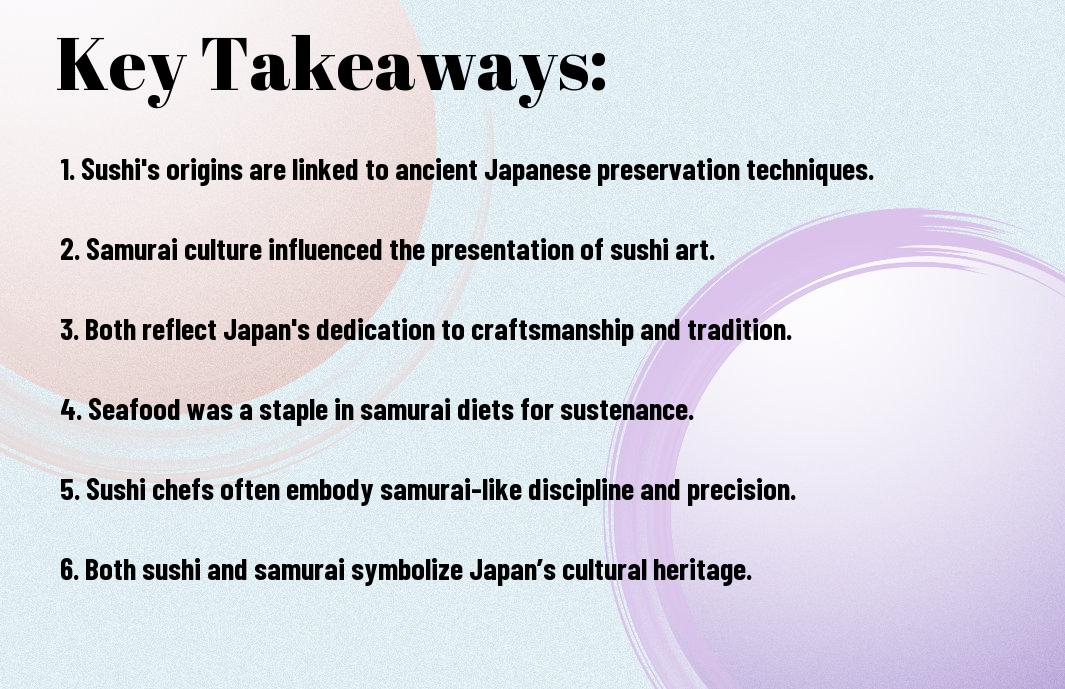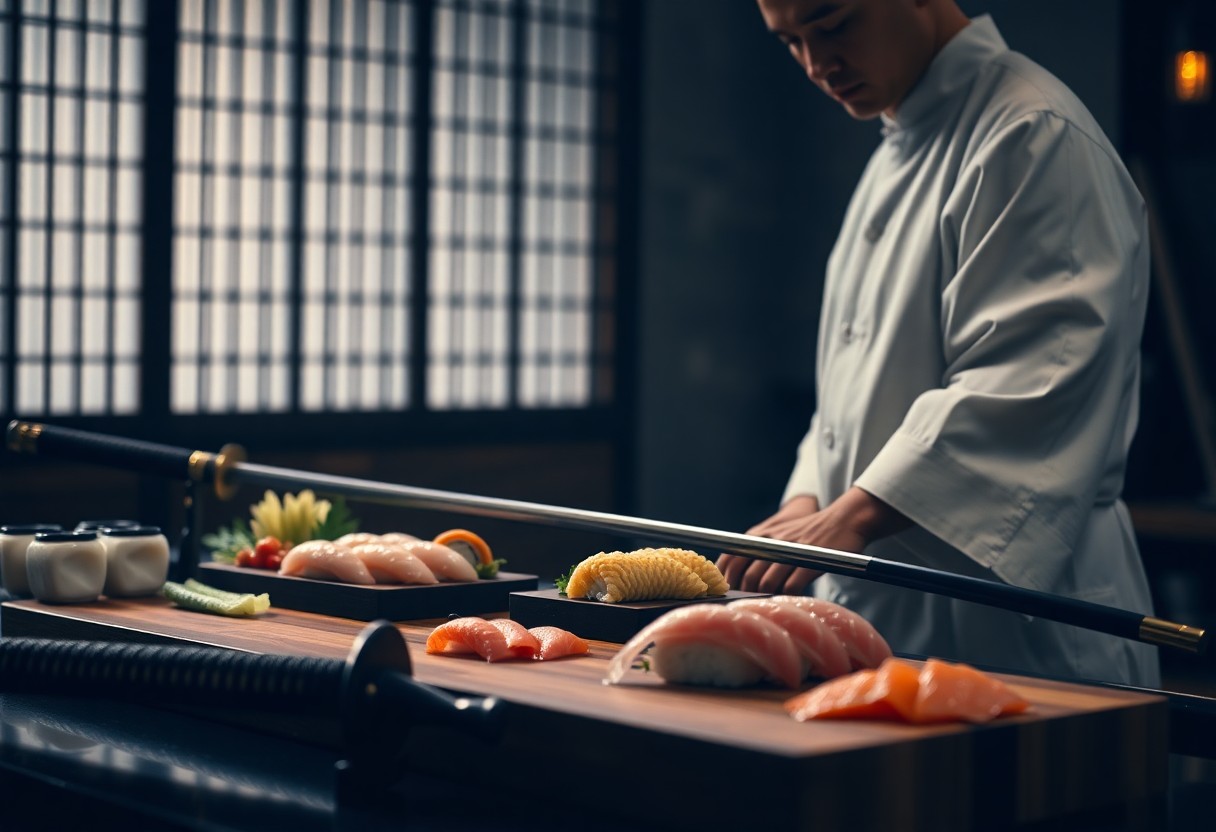Samurai culture has long been a symbol of honor and discipline in Japan, but it also has deep-seated connections to the culinary delight known as sushi. As you research into the history of the samurai, you’ll uncover how their values and lifestyle influenced the art of sushi making. This post will explore the intriguing link between these two iconic elements of Japanese heritage, revealing how the samurai’s principles shaped the evolution of sushi and its role in society. Prepare to be surprised by what you learn about this fascinating relationship!
Key Takeaways:
- Historical Roots: The origins of sushi can be traced back to ancient preservation methods, which share a cultural significance with samurai traditions in Japan.
- Culinary Artistry: Both sushi-making and samurai swordsmanship emphasize skill, precision, and aesthetics, highlighting the dedication to craft in Japanese culture.
- Philosophical Connection: The principles of balance and harmony found in both sushi and samurai ethics reflect a deeper connection to nature and mindfulness in Japanese society.

The Historical Roots of Sushi
While it may seem like a modern culinary trend, sushi has deep historical roots that intertwine with Japan’s cultural evolution. The preparation and consumption of sushi reflect the changing landscape of Japanese society, from ancient fishing practices to the sophisticated dining experience you know today. Understanding these historical developments can enhance your appreciation for this beloved cuisine.
Origins of Sushi in Ancient Japan
Beside the well-known forms of sushi you enjoy today, its origins trace back to ancient Japan when fish was preserved in fermented rice. This method allowed early inhabitants to store food effectively and introduced a unique combination of flavors that laid the foundation for future sushi evolution.
The Evolution of Sushi Techniques
On your culinary journey through sushi, you will notice the remarkable evolution of techniques used to prepare and present this dish. As Japan transitioned from fishing economy to urban sophistication, sushi styles evolved, incorporating new ingredients and methods that reflect the culture and tastes of different eras.
Hence, as you explore the evolution of sushi techniques, you will uncover innovations that led to various sushi types, from nigiri to maki. Each technique showcases a blend of artistry and skill, often passed down through generations, emphasizing the connection between the chef and their craft. Understanding these methods enriches your experience and appreciation for sushi, revealing the thought and tradition behind each creation you savor.
The Samurai: Warriors of Japan
Even today, the image of the samurai evokes a sense of honor and discipline. These noble warriors played a pivotal role in shaping Japan’s history and culture. Emerging during the Heian period, the samurai were not only skilled fighters but also adherents of bushido, the way of the warrior, which emphasized loyalty, courage, and respect. Their legacy continues to influence modern Japanese society, reflecting values that transcend time.
The Role of Samurai in Feudal Japan
Role of the samurai evolved significantly during Japan’s feudal period, where they served as both military leaders and political advisors to the ruling aristocracy. As protectors of their lords’ domains, they engaged in battles and enforced law and order in their territories. This dual role established them as central figures in the feudal system, exerting considerable influence over both the sword and the governance of Japan.
Cultural Significance of the Samurai
With the samurai embodying values that define Japanese culture, their impact goes beyond the battlefield. They are celebrated for their contributions to art, literature, and philosophy, fostering a unique cultural identity. This prominent status in history has led to the samurai becoming symbols of discipline and commitment, admired both within Japan and globally.
The samurai’s cultural significance is deeply rooted in their contributions to the aesthetics and traditions of Japan. They were not merely warriors but also patrons of the arts, influencing everything from poetry to tea ceremonies. This blending of martial prowess and artistic expression created a rich cultural tapestry that resonates even today. As you explore their legacy, you uncover a profound respect for nature, hierarchy, and the importance of inner strength, all of which shape Japan’s identity and values.

The Intersection of Samurai and Sushi
Not many realize that the legendary samurai and the delectable sushi share a rich historical connection. As the samurai upheld values of discipline and honor, their diets were equally reflective of their lifestyle. Sushi, which was once a practical way to preserve fish, evolved into a culinary art over the centuries, highlighting the importance of food in Japanese tradition. For an in-depth look, check out How The Desperate Norwegian Salmon Industry Created A ….
Sushi as a Nutritional Staple for Samurai
Above all, samurai needed a diet that provided energy and strength for their demanding lifestyles. Sushi, rich in protein and crucial nutrients, became a dietary mainstay that fueled their rigorous training and battles. The incorporation of rice paired with fish ensured balanced nutrition, helping to sustain their physical prowess and mental acuity.
Sushi’s Influence on Samurai Rituals and Traditions
Along with being a nourishing food source, sushi also played a role in various samurai rituals and traditions. The aesthetics of sushi, from its presentation to the precision in preparation, mirrored the samurai’s adherence to the principles of Zen and mindfulness. Meals were often seen as a ceremonial experience, signifying respect for resources and the blending of flavors that embodied harmony.
Plus, sushi’s role in ritual ceremonies allowed samurai to demonstrate their social stature and culinary knowledge. Engaging in sushi during important events like tea ceremonies or feasts reinforced community bonds and alliances among the samurai class. You can see how these culinary traditions have been preserved and celebrated, giving you insight into the lifestyle that shaped Japan’s history.
Regional Varieties of Sushi in Samurai Cuisine
After centuries of evolution, sushi has developed regional varieties that reflect the unique resources and culinary traditions of Japan’s diverse regions. Samurai cuisine embraced these varieties, utilizing local ingredients and techniques to create distinct sushi styles. As you explore the different types of sushi, you will discover how geography played a key role in shaping the flavors and presentations that define this beloved dish. Each region’s interpretation contributes to the rich tapestry of Japanese culinary heritage, allowing you to appreciate sushi beyond its surface appeal.
Edo Period Sushi Styles
For many, the Edo period represents the zenith of sushi craftsmanship, introducing styles such as nigiri and maki that are still cherished today. During this time, sushi became a popular street food in Tokyo, reflecting the dynamic culture of the era. As you examine into Edo period sushi, you’ll find that the techniques and presentations used were as much about artistry as they were about flavor, showcasing the evolving relationship between food and society in samurai culture.
The Impact of Geography on Sushi Preparation
Sushi preparation has been significantly influenced by geography, with different regions utilizing local fish, vegetables, and techniques.
In fact, local topography and climate dictate not just the ingredients available, but also how sushi is prepared and enjoyed. For instance, coastal regions often rely on fresh seafood, leading to exquisite nigiri styles, while inland areas may incorporate more preserved or pickled components, resulting in unique rolls. As you explore these regional differences, you will gain insights into how geography has shaped not just sushi, but the broader culinary landscape throughout Japanese history. Understanding these influences enhances your appreciation of sushi as a reflection of local culture and resources.
The Legacy of Samurai in Modern Sushi Culture
Despite the passage of centuries, the influence of the samurai continues to echo in Japanese cuisine, particularly in the art of sushi. Their dedication to mastery, discipline, and respect for the ingredients has shaped how sushi is prepared and served today. This legacy is visible in the meticulous techniques employed by chefs and the profound connection they maintain with tradition, ensuring that each piece of sushi is not just food, but a tribute to the values upheld by the samurai.
Enduring Influences on Sushi Restaurants
The modern sushi restaurant scene is heavily influenced by samurai principles, where respect for tradition manifests in the presentation and preparation of dishes. Many sushi chefs undergo years of training, much like samurai warriors, to perfect their skills. This dedication not only enhances the quality of sushi but also enriches your dining experience, as you witness the artistry behind every plate.
The Samurai Spirit in Sushi Artistry
Before you indulge in your next sushi meal, consider the profound spirit of the samurai that infuses sushi artistry. This historical connection goes beyond mere presentation; it represents a philosophy of precision, respect, and aesthetic beauty deeply rooted in Japanese culture.
Samurai values extend into the practice of sushi-making, emphasizing attention to detail and commitment to excellence. Each cut of fish and arrangement of ingredients are performed with intentional focus, embodying a mindset that seeks harmony in flavor and visual appeal. When you savor sushi, you are not just enjoying a meal—you are participating in a rich cultural legacy that celebrates craftsmanship and respect for the craft, binding the ancient ways of the samurai with contemporary culinary artistry.
Final Words
Presently, you may find yourself enlightened by the fascinating connection between sushi and samurai culture. Understanding this relationship enriches your appreciation for both culinary and historical aspects of Japan. You gain insight into how sushi was not just sustenance but also a powerful symbol of the samurai’s values—discipline, precision, and artistry. As you enjoy a plate of sushi, you can now savor its deeper significance, intertwined with the legacy of the warriors who once dominated the land. This connection enhances your experience and elevates your culinary knowledge.
FAQ
Q: What is the historical connection between sushi and samurai culture?
A: The connection between sushi and samurai culture dates back to the Edo period in Japan (1603-1868), where samurai were known for their strict codes of conduct and discipline. Sushi, originally a way to preserve fish using fermented rice, eventually evolved into the nigiri style we know today, becoming a popular meal among the samurai. These warriors valued quick, portable meals that could fuel them during long battles or travels, making sushi an ideal choice. The blend of artistry and technique in preparing sushi also mirrored the values of the samurai, who practiced their craft with precision and skill.
Q: How did the preparation of sushi influence samurai training and lifestyle?
A: The preparation of sushi required immense focus, discipline, and skill, qualities that were also necessary in samurai training. Techniques such as slicing fish with precision and balancing flavors were akin to the meticulous practice of swordsmanship. This mutual appreciation for craftsmanship elevated sushi-making in samurai society, often performed with a spiritual and ritualistic approach. Additionally, the communal aspect of sharing sushi meals fostered camaraderie, reflecting the bonds of loyalty and friendship highly valued among samurai warriors.
Q: Are there any modern representations of the sushi and samurai connection in popular culture?
A: Yes, modern representations of the sushi and samurai connection can be seen in various forms of media, including movies, anime, and literature. Films that explore samurai themes often showcase sushi as a part of their daily lives, highlighting its significance in Japanese culture. Additionally, anime series may feature characters who embody samurai values while engaging in the art of sushi-making, thereby illustrating the intertwined legacies of these two fascinating elements of Japanese heritage. These representations continue to inspire a greater appreciation for the historical ties between sushi and samurai in contemporary culture.
